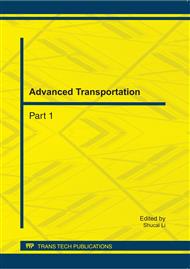[1]
Robertson D. I..TRANSYT: a traffic network study tool[R]. TRL Report LR 253, Road Research Laboratory, Crowthorne. 1969.
Google Scholar
[2]
S.C. Wong, W.T. Wong, C.M. Leung, C.O. Tong. Group-based optimization of a time-dependent TRANSYT traffic model for area traffic control[J]. Transportation Research Part B, 2002, 36: 291-312.
DOI: 10.1016/s0191-2615(01)00004-2
Google Scholar
[3]
Jian Chang, Dawei Wu. Multi-objective intersection signal control model[J]. Journal of Dalian University of Technology, 2000, 40(6): 653-656.(In Chinese)
Google Scholar
[4]
Chengtao Cao, JianminXu. Multi-object traffic signal control method for single intersection[J]. Computer Engineering and Applications, 2010, 46(16): 20-22.(In Chinese)
Google Scholar
[5]
JianqinZeng, Jiajie Wang, Kun Liu, et. al.. CTM-MOGA Based Crossroad Traffic Signal Control[J]. Journal of university of science and technology of china, 2005, 35(2): 284-290.
Google Scholar
[6]
Xinsheng Yao, Xia Luo, Jinyou Du. Traffic Signal Control Based on Satisfactory Multi-Optimization[J]. Computer Engineering and Applications, 2006, 35: 9-10+36.(In Chinese)
Google Scholar
[7]
Yingying Ma, Xiaoguang Yang, YinZeng. Multi-objective Cycle Length Optimization Model and Solution[J]. Journal of Tongji University(Natural Science), 2009, 37(6): 761-765.(In Chinese)
Google Scholar
[8]
Hua Hu, YunfengGao, XiaoguangYang. Multi-objective Optimization Method of Fixed-time Signal Control of Isolated Intersections[C]. The 2010 IEEE International Symposium on Computational and Information Sciences, 2010: 1281-1284.
DOI: 10.1109/iccis.2010.316
Google Scholar
[9]
Schmöcker J. D., Ahuja S., Bell M. G.H. Multi-objective signal control of urban junctions – Framework and a London case study[J]. Transportation Research Part C, 2008, 16: 454-470.
DOI: 10.1016/j.trc.2007.09.004
Google Scholar
[10]
Deb K., Pratap A., Agarwal S., MeyarivanT..A Fast and Elitist Multiobjective Genetic Algorithm: NSGA-II[C]. IEEE Transactions on Evolutionary Computation, 2002, 6(2): 182-197.
DOI: 10.1109/4235.996017
Google Scholar
[11]
Daganzo C. F..The cell transmission model, Part II: network traffic[J]. Transportation Research part B, 1995, 29(2): 79-93.
DOI: 10.1016/0191-2615(94)00022-r
Google Scholar
[12]
Flötteröd G., Nagel K..Some practical extensions to the Cell Transmission Model[C]. Proceedings of the 8th International IEEE Conference on Intelligent Transportation Systems, Vienna, Austria, 2005: 172-177.
DOI: 10.1109/itsc.2005.1520042
Google Scholar
[13]
LI Z. C., CHANG G. L..Modeling arterial signal optimization with enhanced cell transmission formulations[CD]. The 89th Transportation Research Board Annual Meeting, Washington, USA, 2010, #10-2330.
Google Scholar


